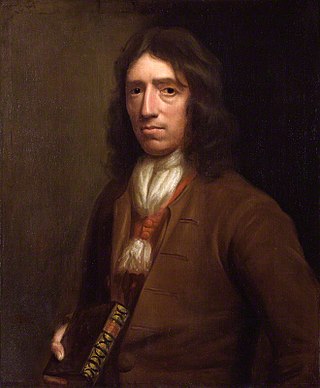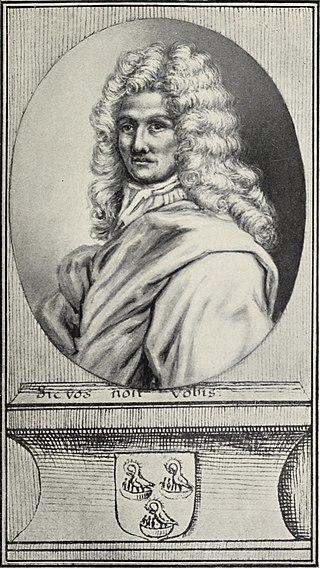
Alexander Selkirk was a Scottish privateer and Royal Navy officer who spent four years and four months as a castaway (1704–1709) after being marooned by his captain, initially at his request, on an uninhabited island in the South Pacific Ocean. He survived that ordeal, but died from a tropical illness years later while serving as a lieutenant aboard HMS Weymouth off West Africa.

The Darien scheme was an unsuccessful attempt, backed largely by investors of the Kingdom of Scotland, to gain wealth and influence by establishing New Caledonia, a colony in the Darién Gap on the Isthmus of Panama, in the late 1690s. The plan was for the colony, located on the Gulf of Darién, to establish and manage an overland route to connect the Pacific and Atlantic Oceans. The backers knew that the first sighting of the Pacific Ocean by Vasco Núñez de Balboa was after crossing the isthmus through Darién. The expedition also claimed sovereignty over "Crab Isle" in 1698, yet sovereignty was short-lived. The attempt at settling the area did not go well; more than 80 percent of participants died within a year, and the settlement was abandoned twice.

William Dampier was an English explorer, pirate, privateer, navigator, and naturalist who became the first Englishman to explore parts of what is today Australia, and the first person to circumnavigate the world three times. He has also been described as Australia's first natural historian, as well as one of the most important British explorers of the period between Sir Francis Drake and Captain James Cook ; he "bridged those two eras" with a mix of piratical derring-do of the former and scientific inquiry of the latter. His expeditions were among the first to identify and name a number of plants, animals, foods, and cooking techniques for a European audience, being among the first English writers to use words such as avocado, barbecue, and chopsticks. In describing the preparation of avocados, he was the first European to describe the making of guacamole, named the breadfruit plant, and made frequent documentation of the taste of numerous foods foreign to the European palate at the time, such as flamingo and manatee.

William Paterson was a Scottish trader and banker. He was the founder of the Bank of England and was one of the main proponents of the catastrophic Darien scheme. Later he became an advocate of union with England.

The Isthmus of Panama is the narrow strip of land that lies between the Caribbean Sea and the Pacific Ocean, linking North and South America. It contains the country of Panama and the Panama Canal. Like many isthmuses, it is a location of great geopolitical and strategic importance.
William Wright was an English privateer in French service and later buccaneer who raided Spanish towns in the late 17th century.
This timeline of the history of piracy in the 1680s is a chronological list of key events involving pirates between 1680 and 1689.
Cinque Ports was an English ship whose sailing master was Alexander Selkirk, generally accepted as a model for the fictional Robinson Crusoe. The ship was part of a 1703 expedition commanded by William Dampier, who captained the accompanying ship, the 26-gun St George with a complement of 120 men.

Samuel Vetch was a Scottish military officer and colonial administrator who thrice served as the governor of Nova Scotia between 1710 and 1717. He was a leading figure in the Darien scheme, a failed Scottish attempt to colonise the Isthmus of Panama in the late 1690s. During the War of the Spanish Succession Vetch was an early proponent of the idea that Great Britain should conquer New France, proposing in 1708 that it be captured and that French colonists in Acadia be deported. Vetch was the grandfather of Samuel Bayard.
The Scottish colonization of the Americas comprised a number of Scottish colonial settlements in the Americas during the early modern period. These included the colony of Nova Scotia in 1629, East Jersey in 1683, Stuarts Town, Carolina in 1684 and New Caledonia in 1698.

Bartholomew Sharp was an English buccaneer and privateer. His career of piracy lasted seven years (1675–1682). In the Caribbean he took several ships, and raided the Gulf of Honduras and Portobelo. He took command of an expedition into the Pacific and spent months raiding settlements on the Pacific Coast of South America including La Serena which he torched in 1680. His flagship, taken at Panama, was the Trinity.

Edward Davis or Davies was an English buccaneer active in the Caribbean during the 1680s and would lead successful raids against Leon and Panama in 1685, the latter considered one of the last major buccaneer raids against a Spanish stronghold. Much of his career was later recorded by writer William Dampier in A New Voyage Round the World (1697).
Captain John Coxon, sometimes referred to as John Coxen, was a late-seventeenth-century buccaneer who terrorized the Spanish Main. Coxon was one of the most famous of the Brethren of the Coast, a loose consortium of pirates and privateers. Coxon lived during the Buccaneering Age of Piracy.
Basil Ringrose was an English buccaneer, navigator, geographer and author.

The Colombia–Panama border is the 339-kilometer-long (211 mi) international boundary between Colombia and Panama. It also splits the Darién Gap, a break across the North American and South American continents. This large watershed, forest, and mountainous area is in the north-western portion of Colombia's Chocó Department and south-eastern portion of Panama's Darién Province.

Edmund Cooke was a merchant captain, buccaneer, and pirate. He is best known for sailing against the Spanish alongside Bartholomew Sharp, John Coxon, Basil Ringrose, Lionel Wafer, and other famous buccaneers. Cooke's flag was red-and-yellow striped and featured a hand holding a sword.

John Cook was an English buccaneer, privateer, and pirate.
Robert Allison was a buccaneer, privateer, and pirate best known for assaulting Spanish Puerto Bello as part of a large flotilla of rovers.
Thomas Magott was a minor pirate and privateer best known for joining a group of buccaneers in assaulting Spanish Puerto Bello.












